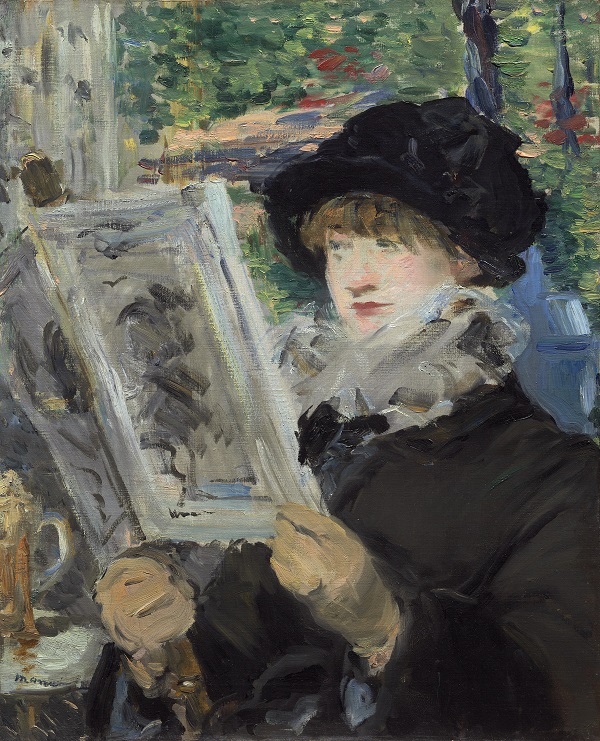
june 17–september 9, 2001
Edouard Manet
Although Edouard Manet (1832-1883) championed the younger Impressionists, he never directly joined their cause by exhibiting with them. Throughout his career, however, he painted works that exploited the speed and immediacy characteristic of informal, rapidly executed oil paintings. These he signed and exhibited, challenging the notion of a finished picture. In The Races at Longchamps he simultaneously represents stationary and rapidly moving forms from the dangerous vantage point of the racetrack. The variety of the brushwork in the canvas is extraordinary: the landscape, the most stable element in the composition, is rendered with viscous paint and large brushes, while the horses and jockeys are expressed with rapid strokes of pigment.
Manet often portrayed the vibrant urban scene of Paris. In Woman Reading, a well-dressed woman sits in an outdoor café and scans the pages of an illustrated journal, her frothy beer at her side. Despite her stationary position, her rapidly executed form and the quickly applied paint elsewhere in the canvas suggest the bustle and commotion of the modern world around her.

Edouard Manet
French, 1832-1883
Woman Reading
1878-79
Oil on canvas
24 1/8 x 20 inches
The Art Institute of Chicago. Mr. and Mrs. Lewis Larned Coburn Memorial Collection

The "point" of Impressionist art was to capture the fleeting moment, the transient effect of a certain place, person, or time. Impressionist artists worked on-site with speed and directness, hoping to distinguish their works with a new freshness, immediacy, and truthfulness. Yet the paintings they exhibited were in fact almost always completed in the studio later. This beautifully illustrated book investigates for the first time the works that might truly be called "Impressions"—paintings that appear to be rapid transcriptions of shifting subjects but were nonetheless considered finished by their makers. Renowned Impressionist scholar Richard R. Brettell identifies and discusses Impressions by some of the best-known artists of the period, including Manet, Monet, Renoir, Sisley, Morisot, Degas, Pissarro, and Caillebotte.
The book surveys the various practices of individual artists in the making, signing, exhibiting, and selling of Impressions. Brettell discusses the pictorial theories behind the paintings, the sales strategies for them, and the various forms they took, including works completed in one sitting, "apparent" Impressions, and repeated Impressions. In a concluding chapter, the author considers a small group of works by Vincent van Gogh, who painted with an almost fanatical rapidity and was the only major Post-Impressionist painter to push the aesthetic of the Impression even further.
This book is the catalogue for an exhibition at the National Gallery in London from November 1, 2000, to January 28, 2001, the Van Gogh Museum in Amsterdam from March 2 to May 20, 2001, and the Clark Art Institute from June 17 to September 9, 2001.
240 pages, 9 3/8 x 11 inches
183 color and six black-and-white illustrations
2000
Published in association with Yale University Press
ISBN 0-300-08446-3 (hardcover)
ISBN 0-300-08447-1 (softcover)
